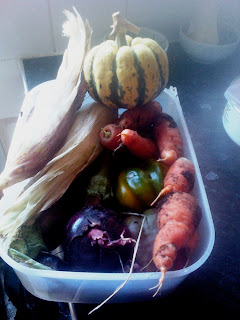 So autumn's here and as the days get shorter and shorter, so does the leaves on the trees become fewer and fewer. We too are preparing for the winter ahead by taking full advantage of the abundance of freely available soil feed, Fallen Leaves. In preparation for winter we have been harvesting and storing as much as we can, and covering the beds with a layer of dead leaves. This mulch will help the soil retain moisture, stay cool and limit weed seed germination. As a bonus the leaves will add nutrients to the soil as they break down, and the worms and soil micro-organisms will work on them as well resulting in lighter, fluffier soil over time.
So autumn's here and as the days get shorter and shorter, so does the leaves on the trees become fewer and fewer. We too are preparing for the winter ahead by taking full advantage of the abundance of freely available soil feed, Fallen Leaves. In preparation for winter we have been harvesting and storing as much as we can, and covering the beds with a layer of dead leaves. This mulch will help the soil retain moisture, stay cool and limit weed seed germination. As a bonus the leaves will add nutrients to the soil as they break down, and the worms and soil micro-organisms will work on them as well resulting in lighter, fluffier soil over time.Dead leaves collection
Once we had harvested most of the crops we then added a one inch layer of crushed up leaves and twigs. The next step was to wet the leaves to speed up the decomposition process.
Mulched Forest Garden
Next, we them added a two inch layer of well rotted leaf mould. This will add humus to the soil, retain moisture and protect the soil from erosion.
One other thing we have been doing in preparation for winter is to prepare our compost bins and collect ready compost. In June we made a hot bed composting system and have already reaped the rewards. In just over four months we were able to make some very humus rich soil.
Well rotted leaf mould
One other thing we have been doing in preparation for winter is to prepare our compost bins and collect ready compost. In June we made a hot bed composting system and have already reaped the rewards. In just over four months we were able to make some very humus rich soil.
Organic Compost
During the time of harvest there is always a large amount of seeds available. All plants, that I know of, all want there legacy to go on, some even go to the lengths of producing hundreds of thousands of seeds. With the success we had with the Nantes carrot seeds we have now began collecting and saving as much of our own seeds as we can. This will help us save money and ensure that what we plant in following seasons will do well on our site.
Seed saving for seed swaps and future planting
Finally our wild spaces. Our experimental mini wild flower meadow produced great results this season so we will be keeping this welcome addition to the garden. We have cut the site in the hope of giving the flowers a chance to compete with the fast growing grass in the spring.
Cut Meadow
The pond has been teeming with life since its' creation in February. All the plants both in and around the pond have taken well, some more than others, and now frogs and toads are a regular site throughout the entire garden.
May Pond in September









































